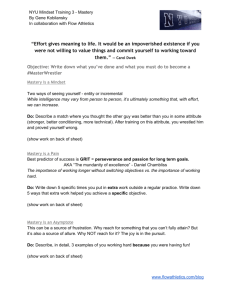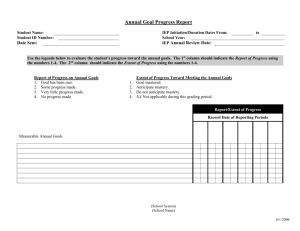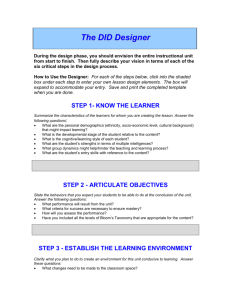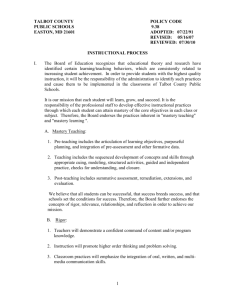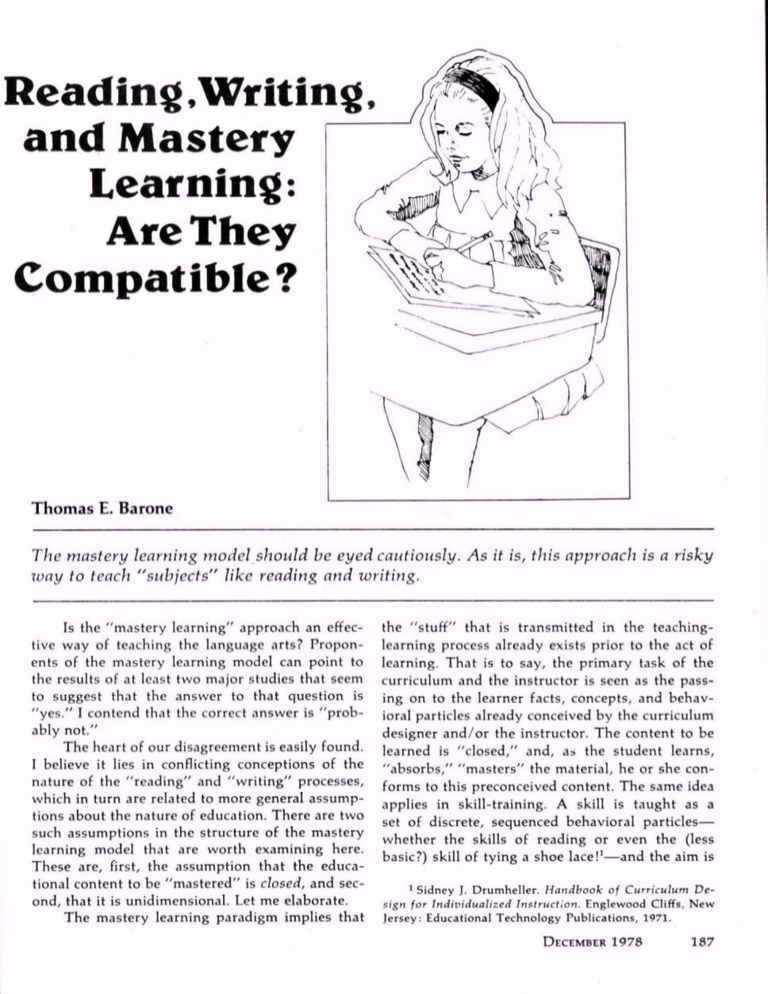
Reading .Writing,
and Mastery
Learning:
Are They
Compatible ?
Thomas E. Barone
The mastery learning model should be eyed cautiously. As it is, this approach is a risky
way to teach "subjects" like reading and writing.
Is the "mastery learning" approach an effec
tive way of teaching the language arts? Propon
ents of the mastery learning model can point to
the results of at least two major studies that seem
to suggest that the answer to that question is
"yes." I contend that the correct answer is "prob
ably not."
The heart of our disagreement is easily found.
I believe it lies in conflicting conceptions of the
nature of the "reading" and "writing" processes,
which in turn are related to more general assump
tions about the nature of education. There are two
such assumptions in the structure of the mastery
learning model that are worth examining here.
These are, first, the assumption that the educa
tional content to be "mastered" is closed, and sec
ond, that it is unidimensional. Let me elaborate.
The mastery learning paradigm implies that
the "stuff" that is transmitted in the teachinglearning process already exists prior to the act of
learning. That is to say, the primary task of the
curriculum and the instructor is seen as the pass
ing on to the learner facts, concepts, and behav
ioral particles already conceived by the curriculum
designer and/or the instructor. The content to be
learned is "closed," and, as the student learns,
"absorbs," "masters" the material, he or she con
forms to this preconceived content. The same idea
applies in skill-training. A skill is taught as a
set of discrete, sequenced behavioral particles —
whether the skills of reading or even the (less
basic?) skill of tying a shoe lace! 1 — and the aim is
1 Sidney J. Drumheller. Handbook of Curriculum De
sign for Individualized Instruction. E nglewood Cliffs, New
Jersey: Educational Technology Publications, 1971.
DECEMBER 1978
187
instructional process is seen as proceeding within
a sequence of steps. After one "level" of the con
tent has been attended to and "mastered," the
learner proceeds to the next, more complex level
of performance. But reading, for one example, is
a much more elaborate, multidimensional process
than is assumed within the mastery learning
paradigm. Lee Cronbach once argued this point
very nicely:
In subjects . . . such as reading comprehension,
achievement is multidimensional. There is the level of
knowing what the author said, and the level of know
ing what the author meant, and the level of under
standing things the author said that the author wasn't
aware he had said. These aspects of reading compre
hension are developed continuously and the child who
has been "brought up to mastery" on only one of the
dimensions probably hasn't mastered the other dimen
sions. Nor does the teacher know what to do to cause
him to "master" reading in all these ways. The teacher
can only hope that repeated interactions with material,
discussed at whatever level the pupil can discuss these
obvious meanings, will successfully move the child
along.2
What Does Research Say?
to transmit the pre-existing, standardized content
of the skill.
There does exist, it seems to me, some "con
tent" that is essentially "closed," for which the
mastery learning approach may be appropriate.
Spelling is an example. Facts and concepts in the
sciences and the social studies need to be trans
mitted to younger generations. There are even
some identifiable skills involved in reading and
writing. The mistake, I believe, is to equate the
entire processes of reading and writing with those
skills. The contents of the latter are closed; the
former includes open-ended activities in which a
person creates meanings from what is read and i n
what one writes. In reading, securing these mean
ings involves interpreting a text within one's per
sonal perspective and making sense of it, ap
preciating it, and even "playing" with it.
The second assumption in the mastery learn
ing model concerning the nature of educational
content is related to the first. Not only is the con
tent-to-be-mastered closed, but it is divisible into
units that are logically sequenced. That is, the
188
EDUCATIONAL LEADERSHIP
But if the mastery learning model is naive in
its conception of what is involved in reading and
writing, what about the research results that seem
to validate its effectiveness for teaching these
"skills?" An extensive review of studies by Block
and Burns examined this effectiveness v is-a-vis
2 Lee J. Cronbach. "Comments on 'Mastery Learning
and Its Implications for Curriculum Development.'" In:
Elliot W. Eisner, editor. C onfronting Curriculum Reform.
Boston: Little, Brown and Company, 1971. pp. 49-55.
various "traditional" teaching methods.3 Only one
dealt with the language arts (Okey, 1975), but
there the results seemed clear: all 14 mastery
groups outscored control groups, seven of them
significantly. 4 These results agree with the "not
overwhelming, but decidedly positive and quite
encouraging" evidence reported from the more
recent Chicago Mastery Learning Reading Pro
gram. 5 Smith and Katims reported that their mas
tery approach to reading, tailored to an urban
Chicago setting, enabled an experimental group,
in terms of "reading ability," to move slightly
ahead of a control group they had lagged behind
just 15 weeks before.
These results are not surprising, but they are
encouraging only if one views the reading and
writing processes in the rather narrow terms of
the mastery learning model. I say this because the
research strategies and evaluation instruments
employed have shared the mastery approach as
sumptions about the nature of reading and writ
ing. Researchers who conceive of a process like
reading as a hierarchical set of skills naturally
reach for available evaluation devices with similar
tendencies. For example, "reading ability in the
Chicago Public Schools," Smith and Katim tell us,
"is unofficially but unambiguously defined as the
reading comprehension score of the Iowa Test of
Basic Skills." 6 The definition was apparently ac
ceptable to them for research use. And Okey used
an achievement test constructed specifically for
his study. The criterion measures that define suc
cess demand a "closed-system" set of perform
ances and capture information only about those
kinds of performances.
But what are the alternatives? Where are the
evaluation strategies of those who see the lan
guage arts in more open-ended, multidimensional
terms? Some such strategies are, at present, "busy
being born." Eisner's notion of educational crit
icism, for example, seems particularly promising
for portraying the nature of student reading and
writing experiences. 7 Certainly Cronbach's notion
of ex post facto hypothesizing could be used for
speculating about the ancillary consequences of
various reading strategies. I think it is time to
employ these and perhaps other newly emerging
evaluation and research strategies to ascertain just
how students' growth in language abilities is
affected by application of the mastery learning
model—and other curricular approaches as well.
Mastery vs. Divergent Learning
Meanwhile, is there any potential danger in
relying solely upon traditional instruments for
" James H, Block and Robert B. Burns. "Mastery
Learning." In: Lee S. Shulman, editor. R eview o f R esearch
in Education, V olume 4. Itasca, Illinois: F. E. Peacock,
1976.
4 J. R. Okey. D evelopment of Mastery Teaching Ma
terials ( Final Evaluation Report, U5OE G-74-2990).
Bloomington: Indiana University, August 1975.
5 Jeffrey K. Smith and Michael Katims. "Reading in
the City: The Chicago Mastery Learning Reading Pro
gram." P hi Delta Kappan 59 ( 3): 199-202; November 1977.
6 I bid., p . 202.
7 Elliot W. Eisner. "On the Uses of Educational Connoisseurship and Criticism for Evaluating Classroom
Life." Teachers College Record 7 8 (3); February 1977.
DECEMBER 1978
189
our information? In my judgment, there could
very well be. Devices like the Iowa Test, along
with similar learning models, carry implicit mes
sages concerning what constitutes verbal literacy.
When we teach reading through the mastery ap
proach and when we define it as the comprehen
sion score on a particular test, are we not also
teaching that reading is, i n toto, a set of skills
attainable in a logical, step-by-step fashion for the
efficient absorption of a piece of literal discourse?
What about abilities to read for aesthetic enjoy
ment rather than only the receipt of a "usable"
communique? What does such incessant literalmindedness do to students' abilities to read and
write poetry? Will a potential for verbal expres
siveness remain nascent? Will students be more
or less apt to write with imagination, with elegance
and style, when to write skillfully is the con
sideration of primary importance?
Mastery learning supporters may argue that
logically their approach is not antithetical to no
tions of divergent learning, that what I am talking
190
EDUCATIONAL LEADERSHIP
about is simple application of the basic skills of
reading and writing, and that before such applica
tion is possible the necessary first steps must be
taken. A person must first master the skills
needed to comprehend a line of written discourse
before he can graduate to the loftier realms of
aesthetics, no?
No. I don't agree. Evidence is mounting that
there are two equally basic modes of knowing and
learning in human cognition: a logical/linear
mode that emphasizes discourse, sequence, and
cultural transmission, and a more holistic, metaphoric mode that is multidimensional, contextual,
and geared to invention and exploration. 8 Rico has
noted the fundamental nature of the metaphoric
mode of knowing, arguing that metaphor is not
... an ornamental linguistic device superimposed
on existing percepts and concepts, [but rather] ... a
8 For
knowing,
Analysis,
sertation,
a full discussion of the metaphoric mode of
see: Gabriele Rico. "Metaphor and Knowing:
Synthesis, Rationale." Unpublished doctoral dis
Stanford University, 1976.
fundamental but non-discursive means of patterning
percepts and concepts different from, but complemen
tary to, logical, discursive patterning.9
Unfortunately our culture has been provid
ing students with a lopsided education, stressing
logical/linear learning at the expense of the meta
phorical mode. The mastery learning model clearly
rests within the prevailing tradition. Yet if stu
dents are not given access to metaphoric learning
activities, if the shape of their learning activities
is always linear and closed, how will their capac
ities for creativity and invention be developed?
We may, of course, decide to simply ignore
this important aspect of human development. We
may wish to join the rising chorus of those who
believe that the most schools can hope to do with
"those kids nowadays" is to equip them with a
set of survival skills. I happen to believe that we
all deserve more than that. I also believe that stu
dents, with appropriate teaching methods and
support from the "significant others" in their
lives, are quite capable of acquiring the abilities to
read and write—in the larger sense spoken of
here.
So is the mastery approach appropriate for
teaching reading and writing? I have tried to
show that the mastery learning model bears im
plicit features that should make educators, at the
very least, suspicious and cautious. But I am more
than ready to admit that more research is needed,
employing new kinds of evaluation tools, to pro
vide us with empirical evidence for making sound
judgments concerning this question. Meanwhile,
I believe that we use the mastery learning ap
proach to teach "subjects" like reading and writ
ing at some risk. "'/.
For Prospective Employers—
Job opportunity center
(or Detroit
Conference Participants
An office for job recruitment will be maintained
during the Annual ASCD Conference (March 3-7,
1979). This is an opportunity for employers to: (1)
report positions available or anticipated; (2) review
and obtain candidate resumes; and (3) schedule
interviews at the Placement Service.
The Job Opportunity Center will be located
adjacent to the conference registration area at
Cobo Hall and will be open on Saturday, March
3 (9:00-3:00). Sunday, March 4 (9.00-4:00), and on
Monday, March 5 (9.00-4 00).
If you are seeking applicants for a position in
your institution, please complete the job vacancy
report below and send it by February 9, 1979 to:
Job Opportunity Center
ASCD
1701 K St., N.W.. Suite 1100
Washington, D.C. 20006
ASCD Annual Conference Placement Service
Job Vacancy Report*
Name of Employer, Institution, School District
Address (street and number, city, state, zip code)
• Name and Title of Person to Contact
'Position Available
Position Description
Educational Requirements
0 I bifi., p. 2.
Experience Requirements
Application Deadline
Salary
Thomns E. Barone is
Assistant Professor of
Education, Northern
Kentucky University,
Highland Heights, Ken
tucky.
Will you be interviewing in Detroit?
___yes
___no
If yes, name and title of representative attending
conference.
* If extra space is needed, please attach addi
tional information.
DECEMBER 1973
191
Copyright © 1978 by the Association for Supervision and Curriculum
Development. All rights reserved.



